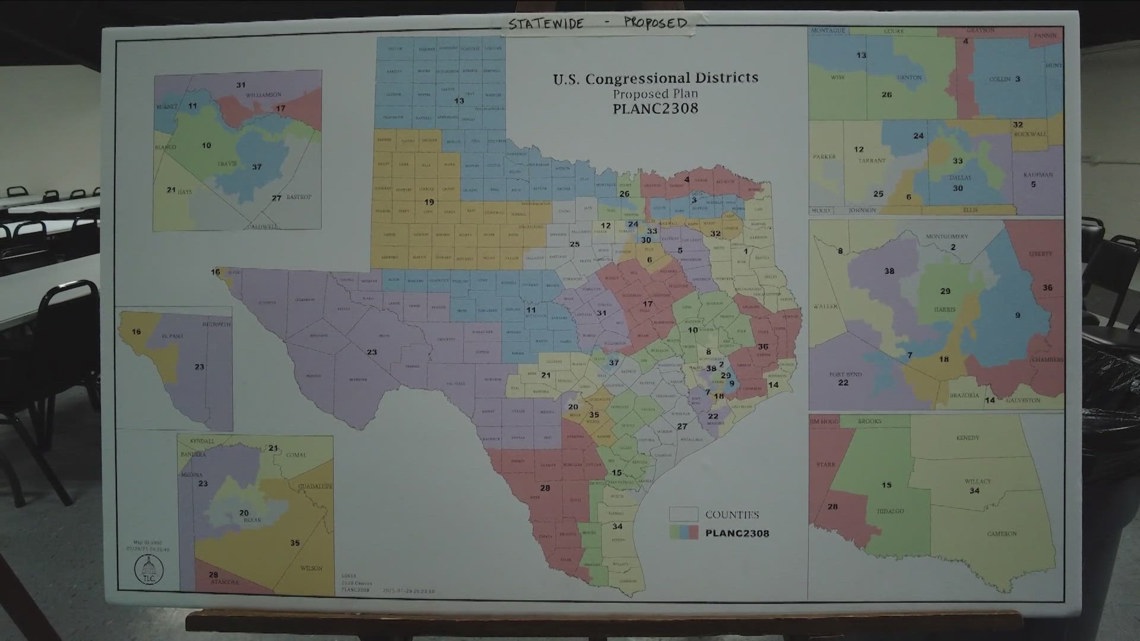
The push to redraw the map follows President Trump’s urging of Texas Republicans to redraw the districts to secure five more Republican seats in the U.S. House.
AUSTIN, Texas — On Saturday morning, the Texas House Select Committee on Congressional Redistricting voted along party lines to advance a new proposed congressional district map to the full Texas House floor for a vote.
The push to redraw the congressional district map follows President Donald Trump’s urging of Texas Republicans to redraw the congressional districts to secure five more Republican seats in the U.S. House of Representatives.
“The effect of these maps is that now a black person is worth only one-fifth. I guess I should feel lucky because people who look like me are worth at least one-third. We are truly doing worse in 2025 Austin than in 1787 Philadelphia,” State Rep. Joe Moody (D-El Paso) said. “This is politics over people in the grossest way possible, which is a power grab. And I feel sick in my soul that we have stooped this low.”
The U.S. Department of Justice has also raised concerns about the state’s current map, which was drawn in 2021 and 2023, saying four districts were drawn based on race. However, Republican lawmakers have stated that this is not the case, claiming the map was drawn fairly.
State Rep. Todd Hunter (R-Corpus Christi), who is carrying the legislation, made it crystal clear that Republicans are not redrawing the map due to constitutional concerns, but rather for partisan advantage.
“I’m not beating around the bush,” Hunter said. “I’m telling you that we have five new districts, and these five new districts are based on political performance.”
Texas Republicans are bullish that Latino voters will continue to shift rightward politically, as they have in recent elections, even though President Trump will not be at the top of the ballot. It’s a move that doubles down on a strategy Republicans were already implementing nationwide, targeting heavily Hispanic U.S. House districts.
The proposed map would add one Hispanic-majority district, bringing the total to 8, and create two new majority-black districts. Four out of five of the districts that Republicans are hoping to flip are majority Hispanic.
“This is all a naked power grab,” State Rep. Erin Zwiener (D-Dripping Springs) said. “I’m furious because it’s going to silence the voices of my constituents.”
Zwiener and U.S. Rep. Joaquin Castro held a people’s town hall in San Marcos on Saturday afternoon.
“There’s a lot not just for the entire community, but there’s a lot at stake for individuals who need help from their members of Congress,” Castro said.
Almost all, 37 of the 38, congressional districts in Texas would be changed to some degree.
The town hall offered those in Hayes County a chance to share their thoughts, as many were unable to attend the public hearings on redistricting that state lawmakers have held over the last several days nor get a chance to testify due to time limits imposed by Republican lawmakers.
“These districts are nonsensical and further disenfranchise the people of color in this state,” Gretchen Pruett said.
Under the current maps, the Western part of Hays County is in District 21, and the I-35 corridor is in District 35.
“We are standing in a Hispanic opportunity district where Latino voters have the opportunity to elect a candidate of their choice,” Zwiener said. “This community right here is going to be taken out of that district and shoved into a district that is overwhelmingly white, where their votes are going to be almost meaningless.”
Under the proposed map, San Marcos would be in District 21, while Buda, Kyle and the Eastern part of Dripping Springs would be in District 27, which stretches to Corpus Christi.
“The elected official is going to be elected from the coast, not to represent their interest on the I-35 corridor. My historic Hispanic communities are going to be buried in overwhelmingly white Hill Country districts that don’t give them a voice,” Zwiener said. “People who are elected to represent them aren’t going to fight for them, and it means they’re not going to get the services they need or the representation they deserve.”
To create the five new Republican seats, the proposed map shifts voters in Austin, Houston, North Texas and the Rio Grande Valley. It puts more Democrats into already Democratic-held districts in some of the state’s biggest cities, such as San Antonio and Houston, and moves around Republican voters from red districts to other Democratic districts.
Democrats argue this mid-decade redistricting would suppress the votes of people of color. However, Republicans reject that assertion, stating that the proposed map adds districts that are majority Hispanic and Black.
While republicans at the Capitol have the votes to pass the proposed map, Democrats aren’t going down without a fight.
“We in the Texas House are going to use every tool we have at our disposal to fight back,” Zwiener said. “There are many phases of the fight. There’s the Texas House, there’s litigation and there’s people holding these folks accountable in the next election.”
Some Texas House Democrats are considering the nuclear option, which is to break quorum and walk out to try and stop the redistricting push.
If Democrats do break quorum, they would face fines of $500 a day and could be forced back to the Capitol by state troopers. It is unclear whether major Democratic donors would be willing to help cover the expenses.
“That is the last lever of hope,” San Marcos City Council Member Amanda Rodriguez said. “If you’re not urging your member to do that, everything else is unserious.”
Zwiener wouldn’t say if she is willing to break quorum or specifically what Democrats plan to do to fight back, but said the House Democratic caucus is keeping all options on the table.
“We are talking together, we are being strategic and we’re going to use every tool at our disposal,” Zwiener said.
The proposed map, House Bill 4, is expected to come up for a vote on the House floor next week.
The House Calendars Committee will meet on Sunday morning to determine what day that will happen.
